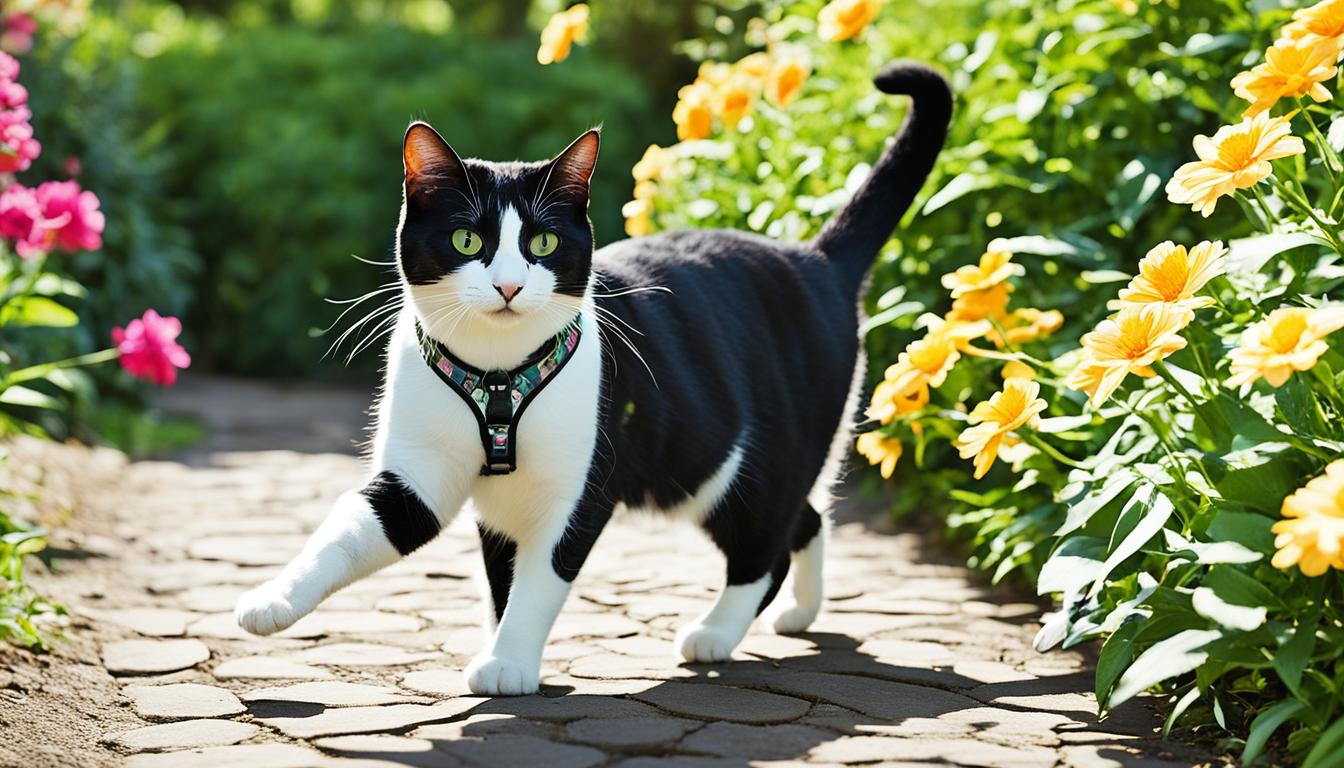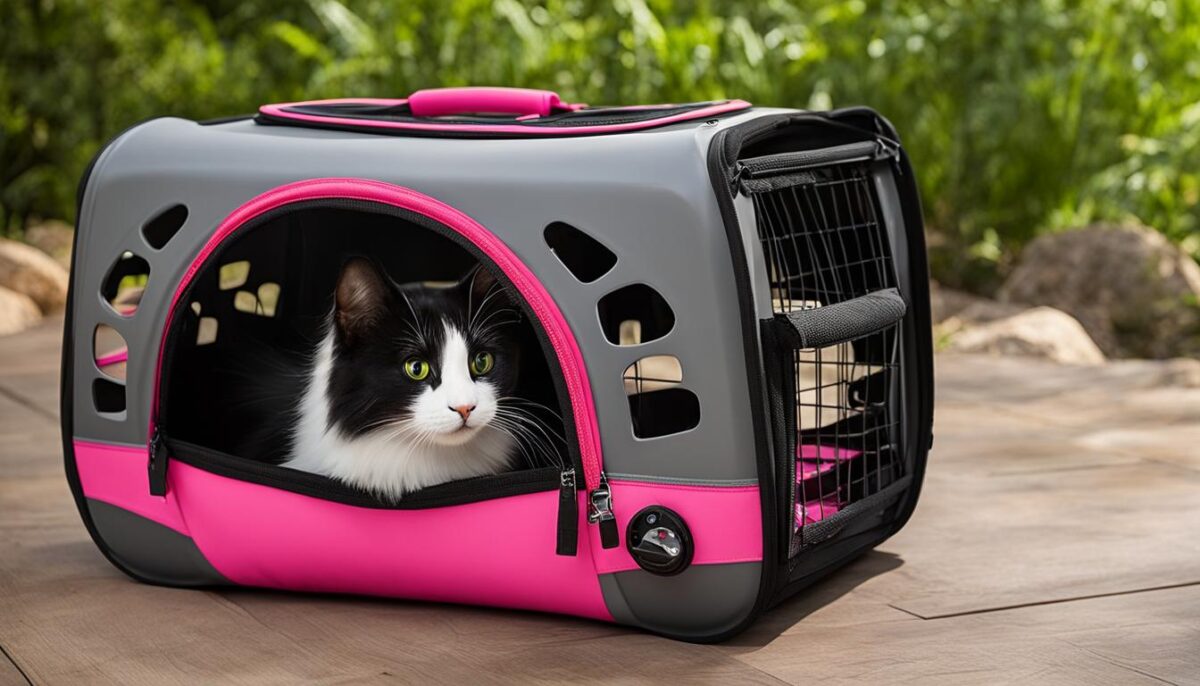Have you ever thought about taking your furry friend on an adventure outside? Yes, your cat! With the right cat harness training, you can enjoy outdoor cat walks together. It’s not just for dogs, cats can have fun too. You will need a secure cat leash to keep your pet safe. It’s exciting to think about having feline outdoor adventures, isn’t it?
But remember, cats are special. They are not like dogs. So, they need a harness that fits them well. This harness should not be for small dogs, but made just for cats. You will also want a leash that is light, like ones made of nylon or cloth. It’s best to start this training inside before stepping out into the big world.
At first, just let your cat wear the harness and get treats. This way, they feel good wearing it. Then you can add the leash, but don’t pull on it. After a while, let your cat feel a little tug while still inside. Treats and patience go a long way. Take it slow, and soon you can lead your cat around the house. When you both feel ready, you can try going outside. Always stay near your cat and end each walk with a smile. If you need more help, you can call 312-645-8253 or email [email protected].
Key Takeaways
- Start with a cat harness that fits and is comfy.
- Use a light leash for walks and learn at home first.
- Give treats and love while training for happy vibes.
- Be patient and go slow for the best results.
- Always watch your cat and keep walks fun.
- If you get stuck, ask an expert for tips.
The Essentials of Leash Training a Cat
When you decide to take your furry friend on their first outdoor adventure, it is important to make sure they have the right gear. The right harness and leash can make all the difference. Let’s dive into how to select the cat walking gear that works best for your kitty’s comfort and security.
Choosing the Right Harness
Finding the perfect harness is crucial for your cat’s walk prep. You want to choose a cat harness that fits snugly, but still lets your cat move freely. This will help keep your cat safe and make sure they can’t wriggle out. A harness should never hurt your cat’s neck, like some collars could. Here’s a simple guide to help you in selecting cat harness:
| Harness Type | Material | Fit | Security Level |
|---|---|---|---|
| H-Style Harness | Breathable Fabric | Snug but comfortable | Medium |
| Vest Harness | Padded Mesh | Close-fitting | High |
| Figure 8 Harness | Nylon Straps | Adjustable tightness | Low |
Understanding the Importance of a Lightweight Leash
Next, let’s talk about leashes. A lightweight cat leash is super important because it doesn’t pull on your cat too hard. Think of it like holding hands gently. You want to be able to tell your cat where to go without making it tough for them. Remember, no retractable leashes, because they can surprise your cat and make them scared or hurt. A short and strong leash is the way to go for control and closeness during your walk.
- Durability: Pick a leash that can last a long time and won’t break.
- Length: A shorter leash gives you better control.
- Handle Comfort: Make sure the leash feels good in your hand.
When you have the perfect cat walking gear, including the right harness and leash, you and your cat will be ready to take on the great outdoors together!
Introducing Your Cat to the Harness and Leash
Teaching your cat to wear a harness and leash is a big step! It’s a way to keep them safe while they have fun outside. Let’s learn how to help your cat get used to their new gear.
Start by letting your cat see and smell the harness. Put it down in a spot they like. The sound of the harness clicking can become a familiar noise. Next, you can gently put the harness on your cat. If your cat looks upset, it’s okay to take it off and try later. Always be kind and go slow.
Acclimating your cat to a harness can be easy with treats and play! Do this when the harness is on to make happy memories. Soon, your cat may think the harness is just part of the fun.
Here’s a table to help you remember the steps:
| Step | What to Do | Tips |
|---|---|---|
| 1 | Let your cat look at the harness and leash. | Put them in your cat’s favorite place. |
| 2 | Make the harness a normal thing. | Let them hear the click of the buckle. |
| 3 | Try putting the harness on your cat. | If they’re not happy, take a break and try later. |
| 4 | Give treats and play with the harness on. | This helps your cat feel good about the harness. |
| 5 | Practice walking indoors with the leash. | Keep it fun and don’t pull hard on the leash. |
Remeber, harness training for cats takes time, and that’s okay. Go step by step, and be patient and your cat will be ready for leash adventures!
Training Steps for Comfort and Safety
Are you ready to help your kitty explore the world safely? Well, you can start right inside your home! Indoor cat leash training is the first step. Getting your cat to feel good in their harness and giving them yummy treats can make it fun for them. Let me show you some easy steps to help your furry friend feel happy and safe, with a cool leash on!
Getting Comfortable Indoors
First things first, let your cat wear their harness and give them lots of treats. This makes them think the harness is a good thing! Let them walk around your home with the leash on, but don’t pull it yet. Your kitty should feel like they are just playing a new game with you.
Learning to Accept Leash Tension
Once your cat looks cool wearing the harness, it’s time for the next move. Hold the leash and let your kitty feel a little pull while they’re doing something they like. This way, they start to learn what it feels like when you walk together. Leash tension familiarity is like teaching them to understand “Hey, I’m still here, and it’s okay!”
Gradual Introduction to the Outdoors
Now for the big moment – going outside! When your cat is doing great indoors, slowly open the door. Place a tasty treat just outside the door to tempt them. This is a super important part of introducing cats to the outdoors. They might be shy at first, so remember, if they don’t want to go out, give them a hug and try again another day.
Following these simple steps one by one will help your kitty learn that the great outdoors can be exciting and safe, with you by their side every step of the way!
Recognizing and Reducing Risks During Outdoor Walks
When you take your furry friend outside for a walk, it’s important to keep them safe. There are things that can make your cat feel scared or not happy. It’s just like how you feel when something scares you. To keep your cat safe when you both go on outdoor adventures, watch for these signs that show if your cat is not feeling good:
- If they keep their body very close to the ground
- Staring at something without looking away
- Looking all around really fast
- A big puffy tail
- Making more noise than usual
- Ears pinned back
Outdoor cat walking risks mean you have to be extra careful so that you and your cat have a fun time together. Always bring a cat carrier with you. If something scares your cat, they can run into it and feel safe. It’s like having a little house for them on the go.
Also, you can carry a soft towel. If your cat feels upset, you can wrap them in the towel to keep them calm and carry them without being scratched.
To make walks fun and safe, learn about recognizing cat discomfort. Then, you can help them feel better. Remember, looking out for cat safety outdoors makes you a super pet friend!
Leash Training a Cat: Building Trust and Confidence
When you’re outside with your cat, remember they have cat outdoor instincts. Think about how your cat might feel in the wide open world. To have positive cat walking experiences, stay close to home at first. You want your cat to trust you. This means taking small steps to build cat trust.
Getting your cat to like walks can be fun for both of you. Let’s look at how you can understand your cat a little better.
Understanding Your Cat’s Instincts
Your kitty may want to chase, climb, or hide when they see new things. It’s all part of their nature. You can help them listen to you even when they’re curious about the world.
Creating Positive Outdoor Experiences
It’s great when your cat enjoys being outside. Start in a quiet spot where there are not too many loud sounds or big movements. Keep walks short and sweet so your cat can learn that the outdoors is a nice place.
Preparing for the Unexpected: Safety Tips and Emergency Responses
Going outside with your cat can be fun. But we must always think of safety first. There are things that you might not expect to happen, like a loud noise that could scare your kitty or another animal that might come too close. You need to be ready to keep your cat safe. This means having a safe place for your cat and knowing what to do if something goes wrong. Let’s talk about carrying a cat carrier and how to stop your cat from running away.
Using a Cat Carrier as a Safe Retreat
If something scares your cat while you’re outside, it’s important to have a safe place for them. A cat carrier for safety is a great choice. Think of it like a safe room for your cat. They can go inside if they get frightened. Carrying your cat carrier means you can keep them close and they won’t run away.
Proactive Measures to Prevent Escape and Stress
Keeping your cat from running away or getting too stressed is key. Here are some simple, easy things you can do to make sure both you and your cat enjoy your time outside:
- Use a strong harness that your cat can’t slip out of.
- Stay close to your cat when you are outside.
- Learn about the places other animals like to go, and avoid those spots.
- Have a plan, like moving away or stopping the walk if something scary happens.
| Emergency Response | Why It’s Important |
|---|---|
| Keep cat ID tags and a microchip up to date | Helps others know your cat has a home if they get lost |
| Talk to your vet | Make sure your cat has all the shots they need to go outside |
Remember, preventing cat escape is easier than trying to find a scared, lost kitty. Keeping an eye on your cat and being prepared can make your adventures outside fun and safe for both of you!
Alternative Methods to Walks for Keeping Your Cat Active
If your kitty isn’t keen on outdoor walks, don’t worry! There are plenty of fun ways to keep them bouncing and pouncing indoors and in safe outdoor spaces. Let’s explore some super cool spots and activities that can turn your cat’s day from lazy to amazing!
Exploring Catios and Enclosed Outdoor Spaces
catios? They’re awesome outdoor patios but for cats! Picture a big space outside, wrapped up in safe mesh. Your cat can jump, climb, and watch birds without wandering off. It’s a purr-fect way to let your fur buddy get fresh air and stay safe.
Interactive Indoor Activities
On the flip side, you can create an indoor playground that’s just as exciting. With indoor cat activities, you can turn any room into a kitty adventure land. Think of fun hoops to jump through, balls to bat at, and even cardboard box mazes. You’ll have your cat moving and grooving in no time!
| Activity Type | Benefits | Examples |
|---|---|---|
| Cat Enclosures | Safe outdoor experience, stimulating environment | Catios, screened porches |
| Indoor Exercise | Safe from outdoor dangers, weather independent | Tunnels, climbing trees, laser pointers |
Remember, the best alternative cat exercise is the one that your cat loves the most. Try out different toys and games to find out what gets your kitty excited. It’s all about keeping your furry friend happy and on the move!
Conclusion
Leash training your cat is a great way to enrich your furry friend’s life with safe cat adventures. It lets them explore the big, bright world while staying out of trouble. Remember, it’s all about taking it slow and easy. Watch how your cat acts and feels about the harness and leash. This shows you when to move forward with training. Always pick a comfy harness and a short leash for the best walks.
Keep your cat’s ID tag up to date, and check with your vet before heading out to make sure they’re healthy. Being prepared is key to making sure each walk is fun and safe. But what if your cat doesn’t love the leash? No worries! There are lots of other ways to keep them active, like playing games inside or hanging out in a catio.
Helping your cat learn to walk on a leash is a wonderful way to have fun together. With patience and the right steps, you’ll both be ready for many exciting journeys. Who knows? You might discover new places right in your backyard!
FAQ
What kind of harness is best for cat leash training?
A snug, comfortable cat harness that does not easily come off is the best choice for leash training. It should fit your cat well without restricting movement and be more secure than a collar to prevent escapes and injury.
What type of leash should I use for outdoor cat walks?
A light, nylon or cloth leash is ideal for outdoor cat walks. It should be short and strong to help you maintain control over your cat’s movements. Avoid retractable leashes as they can pose a risk if your cat moves suddenly.
How do I acclimate my cat to a harness?
Start by letting your cat see and smell the harness, placing it near their favorite spots. Gradually introduce the harness by putting it on for short periods indoors, paired with treats and play to build positive associations.
What are the first steps for leash training my cat indoors?
Begin with your cat wearing the harness at home for treats. Then, hold the leash gently while they walk around, allowing them to feel a small amount of tension. Use praise and treats to encourage and reward them.
How can I tell if my cat is uncomfortable or stressed during walks?
Signs of discomfort or stress in your cat can include a lowered body stance, staring, darting eyes, a puffed tail, noise-making, and ears pinned back. Recognizing these signs can help you respond quickly to your cat’s needs.
How can I help my cat build trust and confidence while walking on a leash?
Encourage your cat to explore and feel comfortable with their surroundings by using treats, praise, and familiar commands. Start near your home and gradually venture further as they become more confident.
Why should I use a cat carrier during outdoor walks?
A cat carrier serves as a portable safe space for your cat in case they become scared or overwhelmed. It’s a secure retreat they can run into instead of possibly running away and getting lost.
What should I do if my cat absolutely refuses to walk on a leash?
If your cat dislikes leash walks, consider alternatives like a catio for safe outdoor time, a cat stroller, or a special backpack for outdoor excursions. Interactive indoor activities can also keep your cat active and engaged.
Should I use a cat harness different from a small dog’s harness?
Yes, it’s important to use a harness specifically designed for cats. Cat harnesses are tailored to a cat’s size and shape, and ensure better security and comfort than those designed for small dogs.
How can I safely introduce my cat to the outdoors?
Gradually introduce your cat to the outdoors by first walking them inside with the harness and leash. Once comfortable, try leading them outside, initially on a calm day and in a quiet, secure environment.
What are some proactive safety tips for cat walking?
Ensure your cat’s harness is escape-proof, keep them close to you, familiarize yourself with the local animal traffic to avoid surprises, and have a plan for quick retreat or movement away from potential stressors.
How vital is microchipping and ID tags when walking my cat?
Microchipping your cat and ensuring they have up-to-date ID tags are crucial for their safety during outdoor adventures. These measures greatly increase the chances of being reunited if they accidentally escape.
Is it necessary to consult my vet before leash training?
Yes, consulting your vet before starting leash training is important to discuss vaccines, flea and tick prevention, and general advice on how to safely enjoy outdoor activities with your cat.


